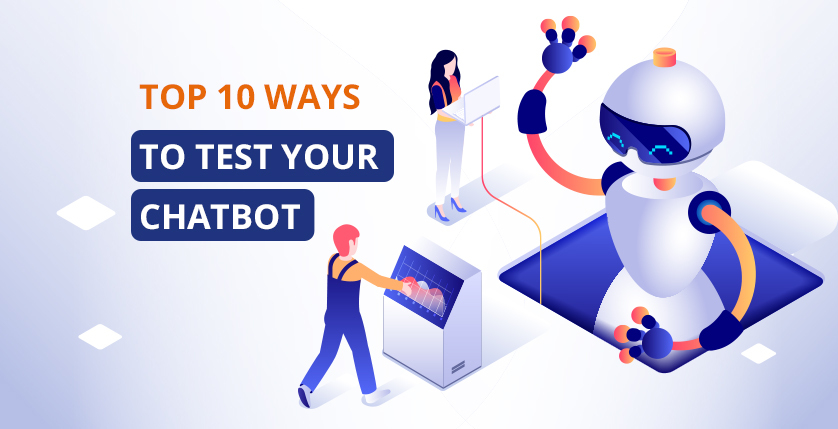
Top 10 ways to test your chatbot
What is a chatbot, and why do you need it?
A chatbot is a program for sending automatic responses to users’ messages. Such answers should be as close as possible to the dialogue with a real person and fully reveal the content of the question.
Chatbots are usually used:
- In the customer feedback section of the sites;
- In social networks and messengers;
- In a telephone conversation with call centers.
Also, there is a separate type of chatbot – personal. We are sure that you have met with them. Those are well-known Siri, Alice, and Cortana.
Most chatbots are based on artificial intelligence: they improve their understanding of human language in the communication process. The other part is controlled by programmed scenarios with several response algorithms.
The mental abilities of a chatbot depend on the technology they are built for.
Machine-based chatbots handle tasks better because they can understand human language. They “gain experience” with the user and can gradually solve incoming situations that are similar to the previous ones.
This distinguishes them significantly from chatbots that run on scripts, as the client does not have to write specific phrases to get relevant answers.
A conversation with a scripted chatbot is built on a specific scenario that significantly narrows the range of issues and problems that the client can solve. Working with scripts requires a technician to manipulate data (questions and answers, links, multimedia materials) competently. Also, he needs to write a script for a chatbot so that users do not lose interest and understanding of the content.
What is the advantage of chatbots?
The popularity of chatbots is due to their economic benefits:
- They allow reducing the number of professionals who process the incoming information manually.
- They can provide feedback to users 24/7.
- They can communicate effectively with customers, maintaining quality service in multiple languages.
How to test a chatbot?
So if you decide to exploit a chatbot, you should test it before allowing it to communicate with customers.
We have prepared the TOP-10 tricks for a thorough test drive of the chatbot.
1. Humanize your chatbot
It is not a test, but it is the first thing you need to do. Give your chatbot a name and create its logo or photo. This will help your customers or employees get used to communicating with it faster. Make it not just a communication mechanism, but a member of your team.
2. Look in all the holes
Involve the chatbot in the conversation and go through all the communication scenarios: from the most commonly used to exceptional phrases and cases.
3. Use specific terminology
To verify the provision of reliable information about a product or service, train the chatbot to accept non-standard words and expressions.
4. Involve developers in the testing process
They need to test the questions and answers of the chatbot during the next assembly. Such a check for developers will be considered a verification and validation that the chatbot provides accurate and relevant answers to the questions of the hypothetical user.
5. Check the chatbot for deadlocks
The conversation between the chatbot and the user must be consistent and have a logical end.
6. Use testing tools
Here are some tools used by QATestLab engineers to improve the work of chatbots:
ChatMapper, Botanalytics, Dimon.
- ChatMapper is a tool for writing and testing nonlinear communications in more complex areas, such as development, e-learning, emergency rehabilitation, health diagnostics, sales, customer service, and strategic planning. In fact, it’s a visual editor that allows you to create dialogs and manage scripts.
- Botanalytics is a service that allows you to test every key aspect of a chatbot: from usability to conversation.
- Dimon is a tool with a distinctive feature: it easily integrates with major platforms such as Telegram, Slack, WeChat, Facebook Messenger. It covers all the functionality of your chatbot during testing.
7. Measure how long the pauses between messages take
When communicating with the chatbot, the user must have enough time to read the text of the message and understand the information provided. The chatbot should not “pour” messages randomly.
8. Check the buttons and quick response menus
To structure the information, the chatbot can use lists or quick response buttons, where the user selects a specific option and can easily navigate in the dialogue.
9. Test the chatbot for meaningless answers
Unfortunately, it is simply impossible to predict all the options that a chatbot will have to face in practice. Still, developers need to take care of “emergency responses” for those exceptions that can be predicted. This is the phase of the testing process when you need to check if the chatbot gives clear answers in “exceptional” scenarios.
10. Reach the logical conclusion of the dialogue
And then check if the user has the opportunity to start a dialogue with the chatbot again. Also, be sure to add a start-up greeting that will appear each time you access the chatbot.
Creating a competent chatbot that will answer all user questions in time and in an accurate manner is a long and painstaking process. The same goes for testing chatbots. Testers and developers should be prepared to customize their chatbot constantly according to user feedback during its work.


